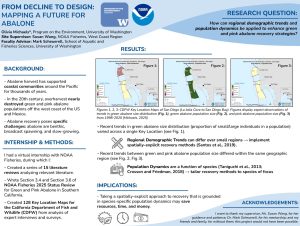Strategic Recovery: Incorporating Regional Dynamics Into Abalone Conservation
Historical overharvest off the west coast of the US and Mexico decimated green (Haliotis fulgens) and pink (Haliotis corrugata) abalone populations throughout the 19th century. In response, the California Department of Fish and Wildlife (CDFW) closed all fishing (commercial and recreational) for green and pink abalone in 1996. Despite nearly 30 years of fishery closures, green and pink abalone populations have not demonstrated strong trends of recovery. The purpose of this study is to identify regional demographic trends and species-specific population dynamics of green and pink abalone in Southern California in order to inform the development of future recovery efforts. To accomplish this, I built the CDFW Key Location Maps through analysis of a series of 14 interviews conducted by NOAA Fisheries in May 2020 to local experts about their perceptions of abalone population health and trends, in which I identified four core demographic trends. I also analyzed scholarly literature published post-2010 in order to build Section 3.4 and Section 3.5 of the 2025 NOAA Fisheries Status Review for Green and Pink Abalone in Southern California. Findings show that species-specific behaviors and population dynamics can influence the efficacy of recovery strategies. Analysis of expert opinion has revealed recent demographic trends that often vary across abalone species and geographic region. These findings demonstrate that effective recovery strategies are those grounded in a strong understanding of regional demographic trends and species-specific population dynamics and behaviors.
